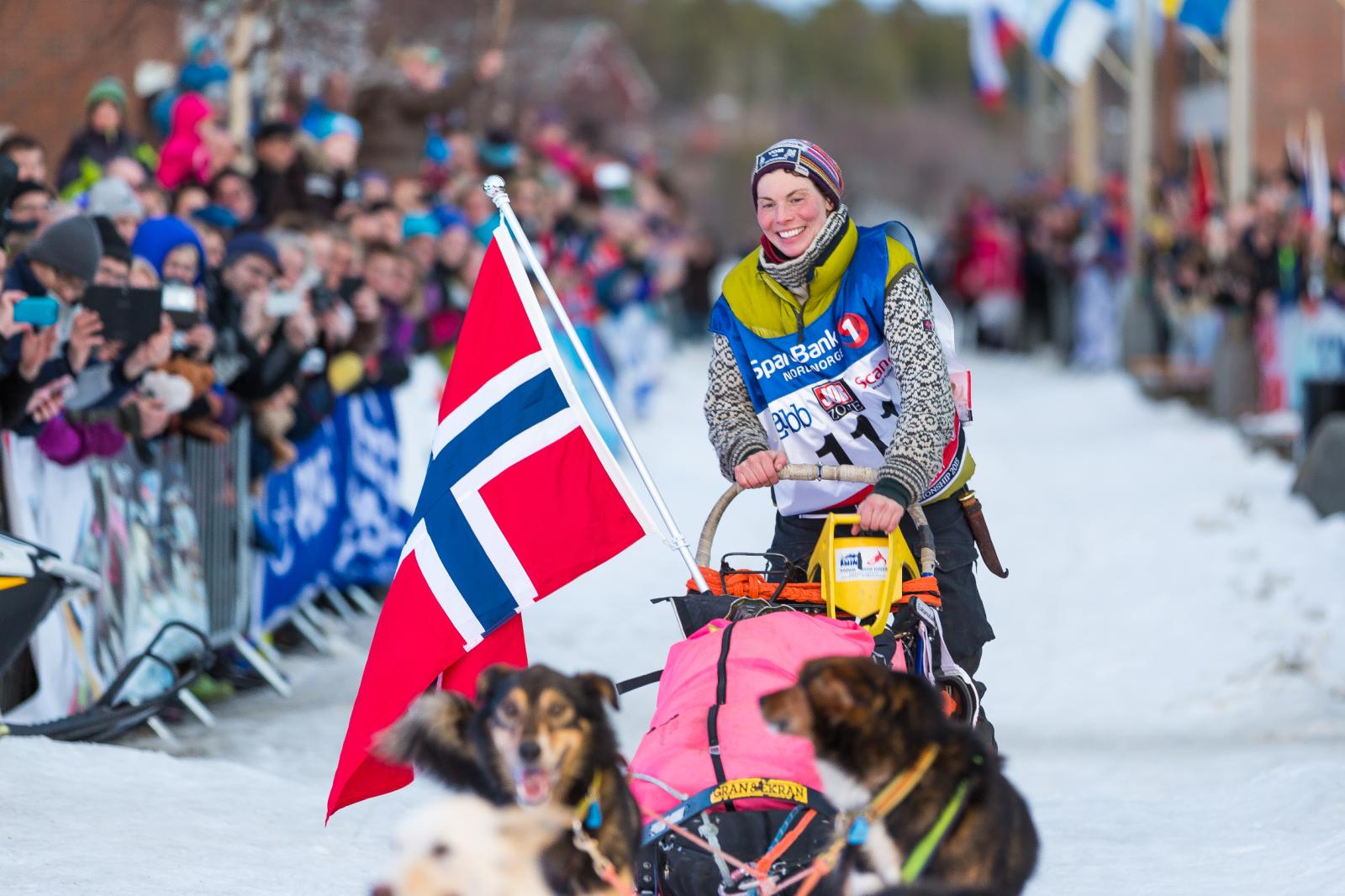
Written by: Rune Waaler og Tor Oskar Thomassen
Date: 25.02.2016 21:57
Rune Waaler, Associate Professor friluftsliv, and Tor Oskar Thomassen, Associate Professor sports, have examined a phenomenon typical of the Finnmark Race the last few years – women winning. This is an article from the school of sports in Alta, UiT the Arctic University of Norway.
Long distance sled dog racing – why do women win?
In the last few years, women have been in the lead in the longest and most demanding sled dog races. Women took the top three positions in the Femund Race Junior in February this year! In the Finnmark Race 2015, Sigrid Ekran won the 1000 km – for the second time in a row. Out of seven women who started in last year’s 1000 km class in the Finnmark Race, six finished among the top 11. In addition, women came in first and second in the 500 km.
In a UiT research project, we have looked at gender differences between men and women’s motivation for long distance sled dog racing. Mushers in the Femund Race and the Finnmark Race have participated in a survey, and the findings show clear gender differences. It is no disadvantage to be woman in long distance sled dog racing.

SUPER EKRAN: Sigrid Ekran won FL-1000 in 2014 and 2015. Photo: Mads Suhr Pettersen.
Women enjoy mushing the most
The results show that women have a stronger inner motivation for mushing. Both women and men score equally high on effort, but women feel both a greater joy and find mushing more valuable than men.
We also see that women score considerably higher on vitality than men. Vitality is a flow-condition in mushing. The musher is engrossed with the activity and handles the interaction with the dogs. She forgets herself, is concentrated and pays attention to the dogs, the terrain and the work tasks of the race. Joy over mushing and a feeling of vitality are tightly connected. It can seem like a flow condition gets the mushers in a state beyond the physical and mental challenges they can face during the race, so they experience a balance between skills and challenges.
Women are less afraid of giving a poor performance
An important gender difference seems to be that women are less afraid of not performing good enough. Men rank their own self-conceived competence (skills and knowledge) in mushing as higher than what the women do, and simultaneously want to avoid performing worse than their competitors. Being afraid of doing worse than other participants can be a psychological break. It can result in an energy draining focus on elements, which one has no influence over. As women see themselves as having a lower competence than men, it may be easier for women to run the race without any self-imposed expectations.

THREE TIMES EDLAND: Elisabeth Edland has won FL-500 three times. Here she is on top of the prize she won in 2015, a Polaris ATV worth about 100 000 Norwegian kroner. Photo: Steinar Vik.
Passion for mushing
Compared to other athletes, mushers score high on passion. But passion can be a double-edged sward – also with mushers. Women score somewhat higher on harmonic passion. It is a form of passion where the participant controls what the passion is directed toward. Mushing as part of life throughout the year, and during the competition, is thus in harmony with other activities in life. This way, the musher controls training, use of time and money spent on mushing
Women also say that the contact with the dogs is a key motivating factors for beginning with mushing in the first place. Good contact with the dogs can determine the experience of joy and flow, and doing well in long-distance sled dog racing.
Women score somewhat lower than men on obsessive passion. An obsessive passion controls you, and causes the mushing to take over in such a way that too much money and time is spent on mushing.
In the period November – April, mushers who participate in the long distances in the Finnmark and Femund races spend an average of 43 hours a week on mushing. Annual costs associated with participating in the Finnmark Race is estimated to around 300.000 Norwegian kroner. It is easy to understand that mushers must be passionate, but the daily work of mushing can become an obsession over time. Here women can be at an advantage since they find that the sport is in harmony with their life in general
The competition motivates
It is during the competition that personality traits like external motivation, self-perceived competency or performance anxiety becomes a factor, for instance in a desire to do well. It can make participants push themselves and the dogs to the limit (perhaps at the wrong time), or the anxiety for failure drains the energy causing poor judgments to be made throughout.
On the contrary, a high degree of inner motivation and a low degree of performance anxiety can make it easier to stick to ones own plan, once the competitors start leaving the check point and your dogs are supposed to rest another hour or two, or changing your plan out of consideration for the dogs or the weather, even though one would like to follow the other competitors. These are things that make it easier to keep a cool head, even when it is “boiling” at the check-point toward the end of the race.

Rune Waaler, Associate Professor friluftsliv, and Tor Oskar Thomassen, Associate Professor sports. Photo: Inger Elin Utsi, UiT.
This is why women win!
We see that both women and men score high on inner motivation and passion for mushing. Compared to other athletes, mushers are ranked high. When women score higher than men on some “positive” psychological variables, this does not mean that the men score low. The men’s motivation is high. It is just that women score even higher on the favorable motivation. Women are even more motivated from the inside.
There will be less mental wear-out related to keeping up over several years if the joy related to the activity is high and the anxiety for failure low. Women participate in the race with less selv-imposed pressure than the men, and are less focused on avoiding failure. This is the reason why more and more women end up on the top of the podium!
